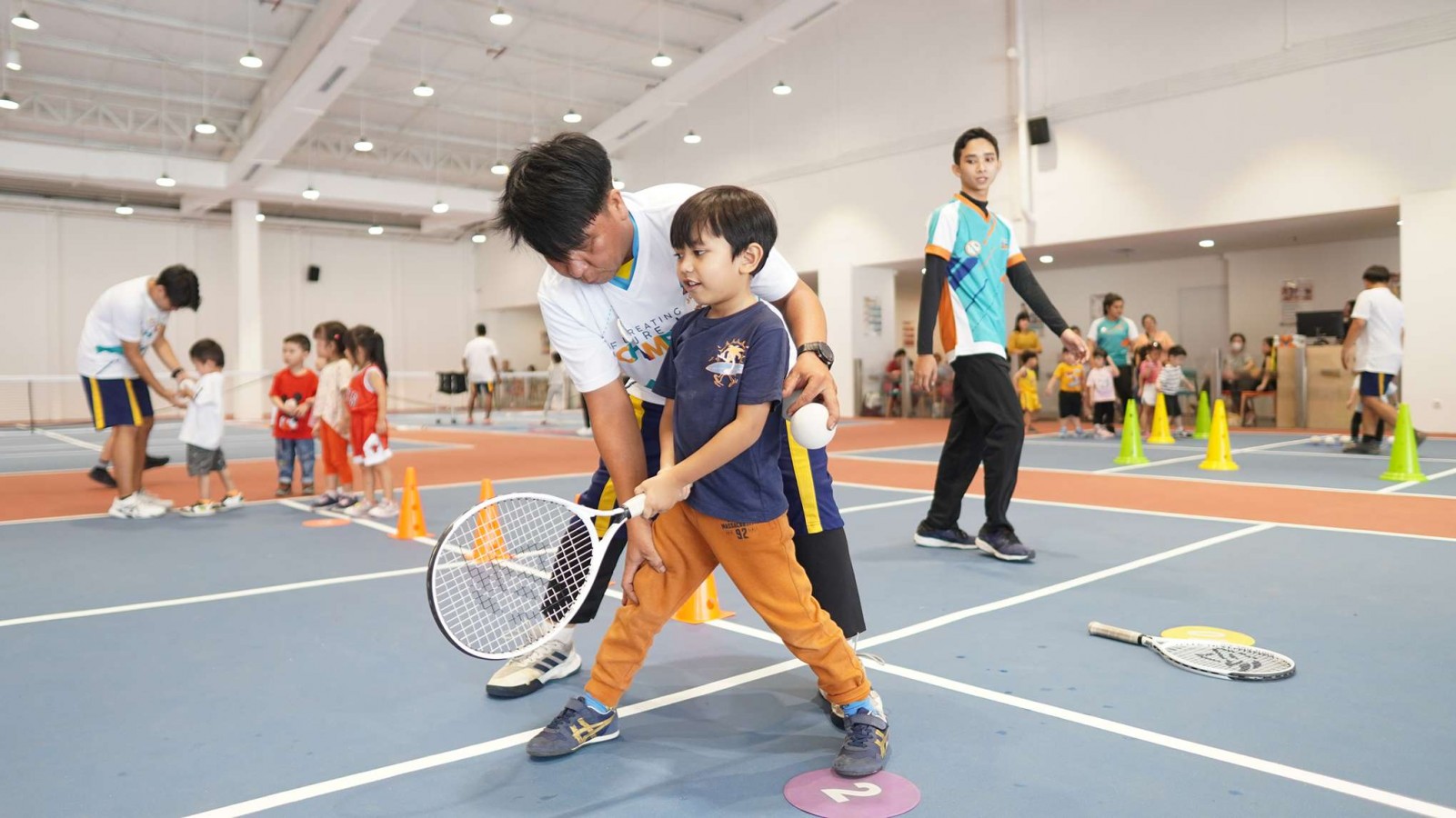The Essential Tennis Warm-Up: How to Prepare Your Body for Play

Warming up before a tennis match is not just about loosening your muscles, it’s an essential part of preparing your body and mind for the demands of the game. A well-rounded tennis warm-up not only prepares your body for the physical demands of the game but also sharpens your focus and enhances coordination.
By incorporating dynamic stretches, mobility exercises, and sport-specific drills, you can elevate your game from the very first serve. In this guide, we'll explore the key components of an effective tennis warm-up, ensuring you're ready to play your best game every time.
Why a Tennis Warm-Up is Crucial
A proper tennis warm-up serves multiple purposes. Firstly, it helps to gradually increase your heart rate, which improves blood circulation to your muscles. This increase in blood flow enhances the delivery of oxygen and nutrients, crucial for optimal muscle performance.
Secondly, warming up helps to elevate your body temperature, making your muscles more pliable and less prone to strain. Finally, a well-structured warm-up routine prepares your joints and tendons for the stresses they will encounter during play, thereby reducing the risk of injuries.
Key Components of a Tennis Warm-Up
A thorough tennis warm-up is crucial for optimizing your performance and minimizing the risk of injuries. Incorporating a variety of exercises into your warm-up routine ensures that your body is well-prepared for the demands of the game. Here are some key components to include in your tennis warm-up:
1. Jumping Rope
Duration: 2-3 minutes
Jumping rope is an excellent way to get your heart rate up and improve your footwork. It engages your calves, improves coordination, and increases overall cardiovascular fitness.
Aim for a steady rhythm, and try incorporating different variations such as high knees or double-unders to keep things interesting.
2. Jumping Jacks
Duration: 1-2 minutes
Jumping jacks are a classic warm-up exercise that helps increase blood flow and engage multiple muscle groups. They are effective for warming up your arms, legs, and core.
Perform jumping jacks at a moderate pace, ensuring you fully extend your arms and legs with each jump.
3. Shadowing
Duration: 3-5 minutes
Shadowing involves mimicking tennis movements without hitting a ball. Focus on practicing your forehand, backhand, serve, and volleys.
This exercise helps reinforce proper technique and prepares your muscles for the specific motions you'll use during a match. Pay attention to your form and fluidity as you perform these movements.
4. Knee Lifts
Duration: 1-2 minutes
Knee lifts are great for activating your hip flexors and warming up your lower body. Stand with your feet hip-width apart and lift one knee towards your chest, alternating legs.
Aim for a controlled, deliberate movement, and engage your core throughout. This exercise also improves balance and flexibility.
5. Butt Kicks
Duration: 1-2 minutes
Butt kicks involve jogging in place while kicking your heels up towards your glutes. This exercise warms up your hamstrings and glutes while improving your cardiovascular endurance.
Perform butt kicks at a moderate pace, making sure to keep your core engaged and maintain a steady rhythm.
6. Mini-Tennis
Duration: 3-5 minutes
Mini-tennis involves hitting the ball over the net using short, controlled strokes from within the service boxes.
This drill helps you get used to the feel of the ball and warms up your strokes in a low-intensity setting. It’s also a great way to focus on precision and technique before transitioning to full-court play.
7. Ladder Drills
Ladder drills involve quick, repetitive foot movements through a flat ladder placed on the ground. Common patterns include:
- One foot per square
- Two feet per square
- In-and-out steps
- Lateral shuffle through ladder
These drills help improve foot coordination, increase step speed, and train your brain to control footwork precisely—perfect for fast direction changes during a match.
8. Cone Drills
Cone drills use multiple cones placed on the court in different patterns. Players run, side-step, or backpedal to different cones on command or based on reaction cues. Examples:
- Zigzag cone run
- Star drill
- Reaction sprint to random cone
These exercises simulate actual match movements, helping you react faster, move efficiently, and recover quickly during rallies.
9. Quick Feet Exercises
Quick feet drills focus on making short, explosive steps that get your body ready to move in any direction. Examples include:
- High knees in place
- Lateral fast feet
- Split step + sprint
These exercises train explosiveness, balance, and court-readiness, so you’re always prepared to return a serve or chase a drop shot.
Essential Tennis Stretching
After your general and dynamic warm-up, it's important to incorporate specific stretches to further prepare your muscles for the game. These static stretches should be performed gently and do for two sets of 10 reps each:
A. Straight Leg March
The straight leg march is an effective stretch for targeting your hamstrings and hip flexors. To perform this stretch, stand with your feet hip-width apart and extend one leg straight out in front of you, keeping it as straight as possible.
As you lift your leg, use your opposite hand to gently pull your toes towards you. Alternate legs, and perform this stretch slowly and deliberately. This exercise helps improve flexibility in the hamstrings and reduces tightness that can affect your mobility on the court.
B. Hand Walks
Hand walks, also known as “inchworms,” are a dynamic stretch that warms up your shoulders, hamstrings, and lower back. Start by standing with your feet hip-width apart.
Bend at the waist and place your hands on the ground in front of you. Walk your hands forward until your body is in a plank position, keeping your legs as straight as possible.
Then, walk your feet towards your hands to return to the starting position. Repeat this movement for several repetitions. Hand walks help to engage multiple muscle groups, improve flexibility, and increase core stability.
C. Standing Trunk Rotations
Standing trunk rotations are excellent for warming up and stretching your torso, shoulders, and lower back. Stand with your feet shoulder-width apart and place your hands on your hips.
Slowly rotate your torso to one side, reaching your opposite hand towards the back, and hold the position for a few seconds. Return to the center and repeat on the other side.
This exercise enhances rotational flexibility, which is crucial for powerful and effective tennis strokes. It also helps to loosen up your core muscles, preparing them for the dynamic movements of the game.
D. Lateral Lunges
Lateral lunges are particularly effective for stretching your inner thighs, quadriceps, and glutes while also improving overall lower body flexibility and strength. To perform a lateral lunge, stand with your feet wide apart.
Shift your weight to one side and bend the knee of that leg while keeping the other leg straight. Lower your hips towards the bent knee and push your hips back, keeping your torso upright.
Return to the starting position and repeat on the other side. This stretch helps increase flexibility in the adductors (inner thigh muscles) and enhances lateral movement, which is essential for quick directional changes on the court.
Warm Up Properly and Play Your Best Game!
A well-executed tennis warm-up is crucial for optimizing performance and preventing injuries on the court. The benefits of a comprehensive tennis warm-up extend beyond just physical readiness; it also enhances mental focus and sets a positive tone for the game ahead.
If you're eager to elevate your tennis skills and experience the excitement of competitive play, our Tennis Program at the Sports & Performing Arts Academy is the perfect opportunity for you!
Our program offers a unique blend of drills and practice sessions tailored for all levels, with special attention to the nuances of touchtennis vs tennis. You’ll have the opportunity to train with experienced coaches and compete in exciting RockOlympics, showcasing your growth and skills.
To get started on your journey, we’re offering a free trial of our Tennis Program, come experience the difference and see how we can help you reach new heights in your game!
FAQ
How to warm-up for a tennis game?
Start with light aerobic exercise like jogging or jumping jacks, then do dynamic stretches such as leg swings and arm circles. Finish with sport-specific drills like shadow swings and mini-tennis.
What to do before playing tennis?
Perform a general warm-up to increase heart rate, follow with dynamic stretching to enhance flexibility, and practice tennis-specific movements to prepare your body for the game.



